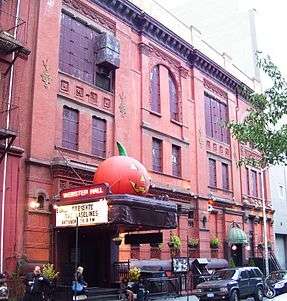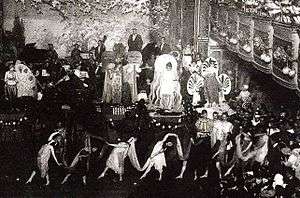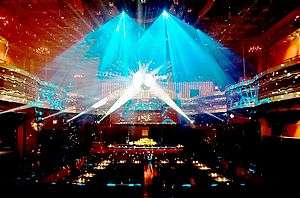Webster Hall
 Webster Hall just before Halloween 2010 | |
| Former names | The Ritz |
|---|---|
| Address | 119-125 East 11th Street |
| Location | New York City |
| Public transit |
New York City Subway: |
| Owner |
Unity Gallega (Casa Galicia of New York)[1] leased by AEG Presents, Brooklyn Sports Entertainment and The Bowery Presents[1] |
| Type | Concert venue, nightclub |
| Capacity |
Grand Ballroom: 1,500 Marlin Room: 600 Studio: 400 |
| Construction | |
| Built | 1886 |
| Renovated | 1992 |
| Website | |
|
www | |
| Webster Hall and Annex | |
|---|---|
 | |
| Coordinates | 40°43′54″N 73°59′21″W / 40.73167°N 73.98917°WCoordinates: 40°43′54″N 73°59′21″W / 40.73167°N 73.98917°W |
| Architect | Charles Rentz |
| Governing body | private |
| Designated | March 18, 2008 |
Webster Hall is a nightclub and concert venue located at 125 East 11th Street, between Third and Fourth Avenues, near Astor Place, in the East Village of Manhattan, New York City. Built in 1886, its current incarnation was opened by the Ballinger brothers in 1992. It serves as a nightclub, concert venue, corporate events space, and recording studio, has a capacity of 2,500 people – including the club; 1,500 for the Grand Ballroom,[2] 600 for the Marlin Room at Webster Hall and 400 for the Studio at Webster Hall.[3][4] It has been recognized as the first modern nightclub.[5]
On March 18, 2008, after a landmarks proposal was submitted by the Greenwich Village Society for Historic Preservation, the New York City Landmarks Preservation Commission designated Webster Hall and its Annex a New York City landmark.[6]
According to Pollstar Magazine,[7] as of August 1, 2016, Webster Hall is the #1 Club Venue in New York by ticket sales, and #3 in the world.[8]
In 2017, the club was sold to Brooklyn Sports Entertainment, a unit of Anschutz Entertainment Group (AEG). It closed on August 9, 2017 for a planned three-year period for structural improvements and will re-open primarily as a concert facility.
1886–1940
Webster Hall was built in 1886 by architect Charles Rentz in the Queen Anne style and topped with an elaborate mansard roof. Six years later in 1892, Rentz was hired to design an addition to the building, occupying the site of 125 East 11th Street and designed in the Renaissance Revival style using the same materials as the original building. Throughout the early twentieth century the building was plagued by fires, which occurred in 1902, 1911, 1930, 1938, and 1949. The original mansard roof was likely lost in one of these fires.[9]
Webster Hall is one of New York City's most historically significant theater and event halls, having hosted social events of all types since the club's construction in 1886.[6] Originally commissioned by Charles Goldstein – who operated the hall and also lived in the Annex with his family until his death in 1898 – the building was a "hall for hire" from its inception.
The first decade or so of Webster Hall's existence saw it host countless labor union rallies, weddings, meetings, lectures, dances, military functions, concerts, fundraisers and other events, particularly focused on the working-class and immigrant population of the surrounding Lower East Side neighborhood during its early years. Although it also hosted many high-society functions catering to the uppertens of the city, the hall earned a reputation as a gathering place for leftist, socialist, Anarchist and labor union activity very early on. In 1912, Emma Goldman, the outspoken exponent of Anarchism, free love and birth control, led a march that brought the children of striking Lawrence, Massachusetts millworkers to the hall for a meal in order to dramatize the struggles of the working-class. In 1916, it was used as the strike headquarters for the International Ladies' Garment Workers Union; in 1920 meetings of the Sacco and Vanzetti Defense Committee were also held at Webster Hall.
In the 1910s and 20s, Webster Hall became known for its masquerade balls and other soirees reflecting the hedonism of the city's Bohemians. Nicknamed the "Devil's Playhouse" by the socialist magazine The Masses, Webster Hall became particularly known for the wilder and more risque events of the time; Marcel Duchamp, Joseph Stella, Man Ray, Francis Picabia, Charles Demuth, Scott Fitzgerald, Bob Brown, and many other notables regularly attended events there during this time.
The coming of Prohibition did not restrict the availability of alcohol at these events. Local politicians and police were said to turn a blind eye to the activities; at one time it was rumored that the venue was owned by the mobster Al Capone. The repeal of Prohibition was the reason for one of Webster Hall's biggest celebrations, "The Return of John Barleycorn."
In 1938, reporting on a fire in the building, The New York Times wrote: "Webster Hall ... began by seeing redcheeked debutantes introduced to society and ended – if ended it has – by seeing red-nosed bohemians thumbing defiance at society."[10]
1950–1979


In the 1950s, Webster Hall began featuring concerts from a diverse group of artists. Latin performers, such as Tito Puente and Tito Rodriguez played at the club. So, too, did folk artists Pete Seeger and Woody Guthrie. From 1953-1968 RCA Records, recognizing the acoustical integrity of the Grand Ballroom, purchased the building and began operating Webster Hall as their East Coast recording venue, Webster Hall Studios. Carol Channing recorded Hello, Dolly! there, Venezuelan conductor Aldemaro Romero recorded his debut album Dinner in Caracas, Harold Prince recorded Fiddler on the Roof, and artists such as Julie Andrews, Harry Belafonte, Tony Bennett, Ray Charles, Perry Como, Sergio Franchi, Peter Nero, Elvis Presley, Frank Sinatra, and Hugo Winterhalter all recorded in the studio.
On February 2, 1962 Bob Dylan was recorded playing harmonica on the title track of Harry Belafonte's Midnight Special album, marking Dylan's recording debut. The Music Theatre of Lincoln Center albums of Broadway shows recorded between 1964 and 1969 were all made at Webster Hall, but without a live audience, and in 1966, the recording of Handel's Giulio Cesare starring Norman Treigle and Beverly Sills was recorded at the Hall for RCA.
In 1970, Unity Gallega, also known as Casa Galicia of New York, purchased the site and remains the current owner of the property. Unity Gallega/Casa Galicia is a cultural organization representing people from Galicia, Spain in promoting and preserving their cultural ties.
1980–2016
On May 1, 1980, The Ritz opened by Jerry Brandt in the Webster Hall building as a showcase venue for emerging rock acts. Tina Turner, Eric Clapton, The Pretenders, Prince, Sting, Aerosmith, U2, Book of Love, Cro-Mags, KISS, B.B. King, and Guns N' Roses all performed on what was routinely called, "the best stage in New York City." Many believe The Ritz to be the first nightclub to feature a video component.
When the Ritz relocated in 1989, it gave Webster Hall the opportunity to be reborn. In 1992, the Ballinger brothers (Lon, Stephen, Douglas, and Peter) from Toronto unveiled the restored Webster Hall, featuring state of the art audio, video, and lighting technology with the original color scheme recreated. The venue hosted two or three different genres of music at once on weekend evenings, providing rave/house music in their large dance room and rock in the upstairs billiard area. A facility capable of catering to groups of 100 to 2,000, Madonna, Mick Jagger and Bill Clinton have had events there, as has the World Wrestling Federation TNA Wrestling and the taping of Fuji Television Network's Iron Chef "New York Special" between Bobby Flay and Masaharu Morimoto. The venue offers five different rooms.

As real estate development pressure grew exponentially in the East Village during the 2000s, the Greenwich Village Society for Historic Preservation saw the need to protect the scale and character of many of the East Village’s unique historic structures. In the summer of 2007, GVSHP supplied the Landmarks Preservation Commission with extensive research on the history of Webster Hall, and urged the LPC to landmark the site. Shortly thereafter the LPC commissioners voted to consider the building for landmark designation and in spring 2008 the building was officially designated a New York City landmark, recognizing its significant role in the cultural development of the Village.[11] From 1993-1997, and starting again in 2008 through today, Gerard McNamee has been the director[12] of Webster Hall, hiring all of the current staff members and guiding the club through its most prestigious period[13].
In addition to its weekly club nights, Webster Hall is one of the city's premiere live music venues. It is the exclusive live music venue for AOL’s New York Broadband Rocks series. On May 11, 2007 Linkin Park filmed their Minutes to Midnight Promo Concert, which was then released into theatres. The club entered into a partnership to present The Bowery Ballroom Presents at Webster Hall concert series, which has already brought such acts as Sonic Youth, Infected Mushroom, The Hives, John Mayer, John Butler[14] and Modest Mouse to the mainstage.[15] In October 2008, "The Studio at Webster Hall," a 300 to 400 scalable capacity performance room, was opened.[16] Bowery Presents' contract with Webster Hall expired in August 2014, and Webster Hall chose to take all their concert bookings "in-house", led by Heath Miller.[17] Since taking their concert bookings in house for all events starting in August 2014, Webster Hall has gone on to present acts such as Charli XCX, Tove Lo, Buzzcocks, Clean Bandit, Wiz Khalifa, American Football (3 sold-out nights), Bleachers, CocoRosie, James, MØ, Chet Faker, Modern Baseball, Metallica, Green Day, Lenny Kravitz, Faith No More, LCD Soundsystem, JoJo, Good Charlotte and Capital Cities, amongst others.
In fall of 2016 trade publication, Pollstar nominated the venue for their Nightclub of the Year Award.[18] The club won the award at Pollstar's annual award ceremony at Pollstar Live! the following February. [19]
2017
It was announced on April 2, 2017 that Webster Hall has been sold to Brooklyn Sports Entertainment,[20] a unit of Anschutz Entertainment Group – known as AEG. On May 4, all employees were served termination notices[21]. On May 22 it was reported that Webster Hall would close in mid-August for approximately two years,[22] and would reopen in late 2019/early 2020 as Spectrum Hall, which would be strictly a concert and sports facility.[23]
In July 2017 Gerard McNamee, the club's director, officially announced that the venue would close after the final show on August 9, 2017, and that it had been purchased by Brooklyn Sports Entertainment. The closing, to update the building's infrastructure for modern use, was planned to be for a period of three years. After that, AEG will present fewer dance nights and more concerts.[24]
References
- 1 2 Staff (April 3, 2017) "Brooklyn Sports & Entertainment Partners with The Bowery Presents to Acquire Operating Rights to New York's Iconic Webster Hall" (press release)
- ↑ "Webster Hall in New York". Rolling Stone. Retrieved 2016-08-02.
- ↑ "5 of The Best Local Music Venues in Lower Manhattan - Rivington Music Blog". 2016-01-02. Retrieved 2016-08-02.
- ↑ Carlson, Jen (2007-08-14). "New Venue Alert: Terminal 5". Gothamist. Archived from the original on 2010-02-10. Retrieved 2011-11-10.
- ↑ "Webster Hall, 119 East 11th Street was built in 1886 and designed by Charles Rentz" (PDF). Gvshp.org. Retrieved 2017-05-27.
- 1 2 "Webster Hall and Annex Designation Report", New York City Landmarks Preservation Commission (March 18, 2008)
- ↑ "PollstarPro: 2016 Mid Year Special Features". Retrieved 2016-08-02.
- ↑ "2016 MID YEAR SPECIAL FEATURES" (PDF). Pollstarpro.com. Retrieved 2017-05-27.
- ↑ Durniak, Drew. "Where Music and Passion are Always in Fashion". Greenwich Village Society for Historic Preservation. Retrieved July 18, 2011.
- ↑ "Webster Hall (article abstract)". The New York Times. Retrieved 2017-05-27.
- ↑ "Webster Hall Landmarked!". Greenwich Village Society for Historic Preservation.
- ↑ "Public Sex and Hidden Knives: The Nightmares of Managing a Massive Club Halloween Party". Vice. Retrieved 2017-08-11.
- ↑ "Webster Hall staff members reflect on the closure of the iconic venue". Time Out New York. Retrieved 2017-08-11.
- ↑ "Coast 2 Coast Music Industry Mixer | New York 1/26 | Coast 2 Coast Events". Coast2coastmixtapes.com. 2012-01-26. Retrieved 2017-05-27.
- ↑ "Webster Hall New York, NY - tickets, information, reviews". Newyorkcitytheatre.com. Retrieved 2011-11-10.
- ↑ "The Studio at Webster Hall". Webster Hall. Retrieved July 8, 2012.
- ↑ "Webster Hall To Handle Booking In House". Webster Hall.
- ↑ "Webster Hall VP Heath Miller Talks Pollstar 'Nightclub of the Year' Nomination". Billboard. Retrieved 2017-07-07.
- ↑ "How a Business Predicts the Future: Heath Miller of NYC's Iconic Webster Hall". Inc.com. March 8, 2017. Retrieved 2017-07-07.
- ↑ Atkinson, Claire (2017-04-03). "Webster Hall is getting a makeover". New York Post. Retrieved 2017-06-02.
- ↑ "Department of Labor Warn Notice for Webster Hall".
- ↑ Plitt, Amy (2017-05-22). "Harlem's Whole Foods gets an opening date, Webster Hall renovations, and more". Curbed NY. Retrieved 2017-06-02.
- ↑ "Community Board 3 Calendar - Community Board No. 3". www.nyc.gov. Retrieved 2017-06-15.
- ↑ Hobbs, Allegra (July 10, 2017) "Webster Hall to Close for Renovations in August, Operator Says" Archived 2017-08-06 at the Wayback Machine. DNAinfo
External links
| Wikimedia Commons has media related to Webster Hall and Annex. |
- Official website
- New York Press article
- Building database Rentz has 51 entries as architect
- Flash video of the exterior
- Designation Report of the Landmarks Preservation Commission
- Webster Hall on Clubplanet
- match2blue Homepage